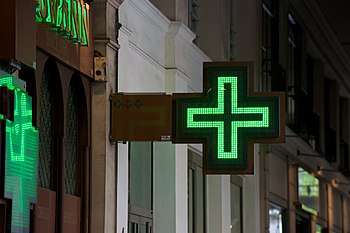Pharmacy (shop)
A pharmacy (also called "drugstore" in American English or "community pharmacy" or "chemist's" in Commonwealth English) is a retail shop which provides prescription drugs, among other products. At the pharmacy, a pharmacist oversees the fulfillment of medical prescriptions and is available to give advice on their offerings of over-the-counter drugs. A typical pharmacy would be in the commercial area of a community.

Characteristics of a good pharmacy
The American Association of Colleges of Pharmacy recommends that consumers choose a pharmacy at which they can have a consulting relationship with the pharmacist.[1] Anyone using drugs benefits when they have easier access to a pharmacist. Being timely includes both processing the request quickly and having drug stock available to fill the prescription.[1] Some consumers need drugs delivered to their home, perhaps by mail, and may select a pharmacy which offers that service.[1] Different pharmacies may charge different prices for the same drugs, so shopping for lower prices may identify a pharmacy offering better value.[1] In addition to fulfilling prescriptions, a pharmacy might offer preventive healthcare services like vaccinations.[1] Up-to-date technology at a pharmacy can assist a patient with prescription reminders and alerts about potential negative drug interactions, thereby reducing medical errors.[1]
Duties
The International Pharmaceutical Federation has declared their vision of a community-based pharmacist:[2]
- An expert in pharmaceutical care, pharmacotherapy and health promotion
- A professional communicator with patients, other healthcare providers and decision makers
- Deliver high quality products, services and communication
- Document their work and communicate the outcome to professional colleagues.
Responsibilities
Community-based pharmacists' responsibilities include: checking and dispensing of prescription drugs, providing advice on drug selection and usage to doctors and other health professionals and counseling patients in health promotion, disease prevention and the proper use of medicines.[3]
In most countries regulations govern how dispensaries may operate, with specific requirements for storage conditions, equipment and record keeping.
Clinical roles
It is becoming more common for pharmacists to take on extended roles that provide more clinical care directly to patients as part of a primary care team. There are around 11,400 community pharmacies in England. Many are open for extended hours in the evenings and weekends and they are accessible without appointment.[4][5]
United Kingdom
In the English NHS there are 438 million visits nationally to community pharmacies a year for health related reasons. More than 1 billion prescription items were dispensed in 2012. More than £14 billion is spent on prescribed drugs annually.[6] Under the 2005 NHS Community Pharmacy contract all community pharmacists in England and Wales provide:[7]
- Dispensing Service
- Repeat Dispensing Service: This allows the patient to collect regular repeat prescription medicines for an agreed period of time, without having to go back to their GP
- Disposal of Unwanted Medicines.
- Promotion of Healthy Lifestyles.
- Signposting to other Services.
- Support for Self-Care: advice on treating minor illnesses and long term conditions.
Widely available Advanced Services:
- Medicines Use Review & Prescription Intervention.
- New Medicine Service. For patients who have been given their first prescription for a medicine to treat Asthma and COPD, Type 2 diabetes, Hypertension or Anticoagulant Therapy.
- Appliance Use Review Service.
- Flu Vaccination.
Enhanced Services which are not available unless locally commissioned:
- Minimising Adverse Effects and Admissions Related to Medicines.
- Discharge and Transfer Planning.
- Managing Dental Pain.
Support staff
To help pharmacists be able to take on extended roles, it is common for them to work as part of a team that can include pharmacy technicians, dispensing assistants and counter assistants.[8]
Ownership
In parts of mainland Europe, the pharmacist is required to own the pharmacy of which she or he is the licensee. Under this arrangement, a pharmacist can be the operator of only a single outlet.[9] In the UK, 60% of all community pharmacies are owned by companies that own multiple pharmacies.[10]
In the United States, more than 25% of independent owners have ownership in two or more pharmacies.[11]
Most of New Zealand's community pharmacies are owner-operated.[12] In Australia, pharmacists recognise the need to integrate professional pharmacy services into the health system to meet the changing health care needs of the population.[13]
Society and culture
A survey conducted by PrescribeWellness found that almost half of Americans older than 40 years-old value pharmacies that offer preventative care services, and would be willing to transfer their prescriptions to pharmacies that offer those services.[14] Patients also value pharmacies where they can receive medical advice concerning their prescription medications, how those medications may interact with each other, and receive over-the-counter drug recommendations for the management of common ailments.[14] In a survey of over 1,000 U.S. adults older than 40 years-old conducted by Propeller Insights, 67% of patients responded that they would prefer that their pharmacist discuss new prescriptions with them, rather than their physician, because they viewed their pharmacist as "better at explaining side effects and has more time to spend with them."[14]
Gallery
 Contemporary pharmacy in an older building
Contemporary pharmacy in an older building A chain store pharmacy in the United States
A chain store pharmacy in the United States- A pharmacy in Norway that is part of a shopping mall
 Interior of a pharmacy in Ethiopia
Interior of a pharmacy in Ethiopia
References
- "Pharmacy Buying Guide". Consumer Reports. May 2016. Retrieved 13 February 2017.
- "Community Pharmacy Section". International Pharmaceutical Federation (FIP). Retrieved 8 July 2014.
- "What pharmacists do and where they work". Pharmaceutical Society of Australia. Archived from the original on 30 March 2014. Retrieved 8 July 2014.
- "Pharmacy". Scottish Government. Retrieved 8 July 2014.
- "Careers in pharmacy: Pharmacy roles: Community pharmacy". Royal Pharmaceutical Society (RPS). Retrieved 8 July 2014.
- "How the health system is skewed towards harm for pill-popping pensioners". EconoTimes. 27 November 2015. Retrieved 30 November 2015.
- "About community pharmacy". Pharmaceutical Services Negotiating Committee. Retrieved 30 November 2015.
- "About Community Pharmacy". Pharmaceutical Services Negotiating Committee. Retrieved 8 July 2014.
- "Pharmacy in Europe: France". Employed community Pharmacists in Europe (EPhEU). Retrieved 8 July 2014.
- "News from UK". Employed community Pharmacists in Europe (EPhEU). Retrieved 8 July 2014.
- "Independent Pharmacy Today". National Community Pharmacists Association. Retrieved 8 July 2014.
- Gauld, Natalie (8 December 2010). "Sun, surf, snow and pharmacy- pharmacy practice in New Zealand". PJ online. Retrieved 8 July 2014.
- "Principles for Community Pharmacy Agreements". Pharmaceutical Society of Australia. Retrieved 8 July 2014.
- Vecchione, Anthony (February 2018). "Patients Prefer Pharmacies That Offer Preventive Care". DrugTopics. 162 (2): 6.